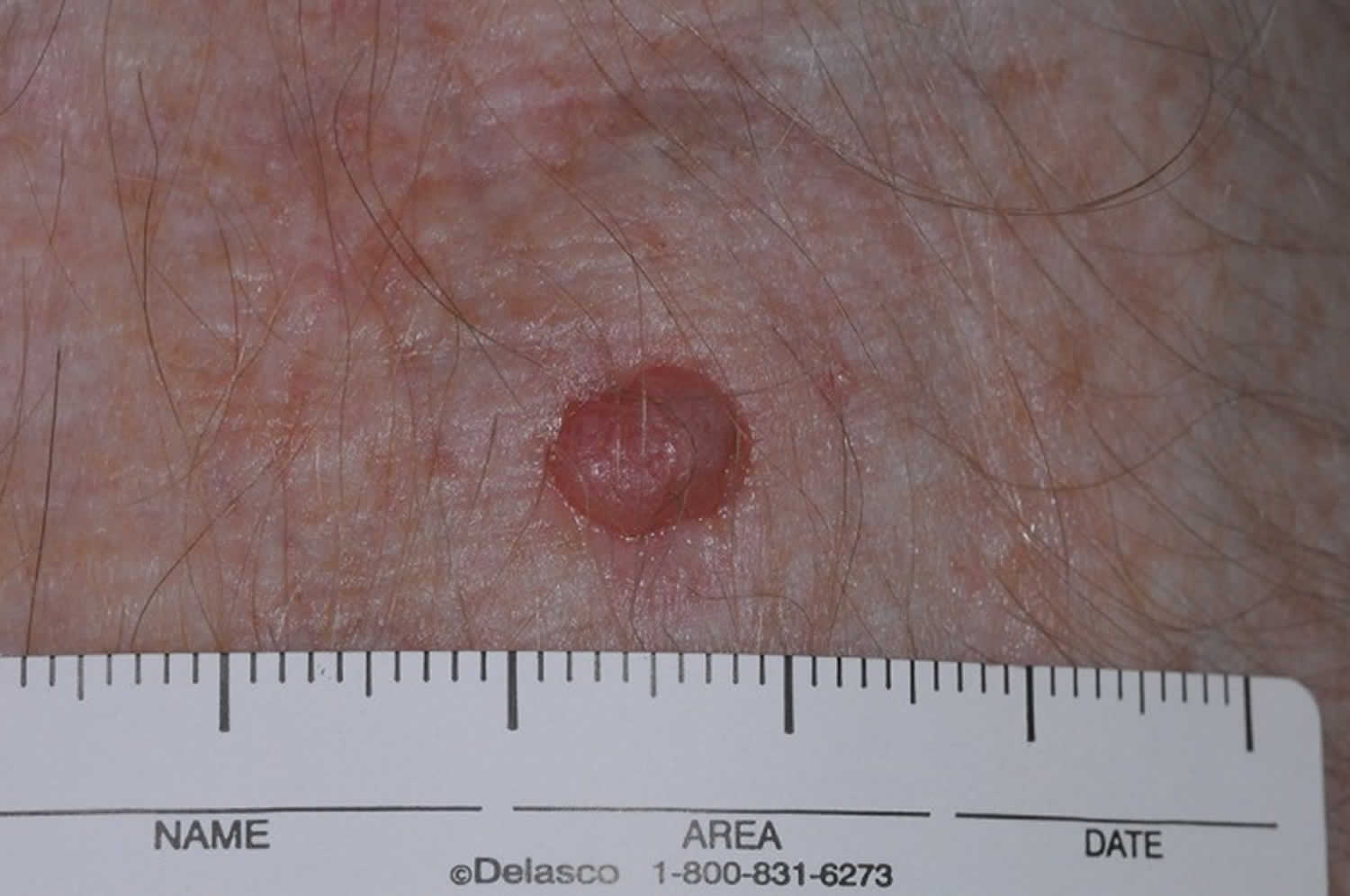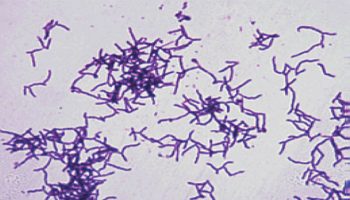Inverted follicular keratosis
Inverted follicular keratosis is a benign tumor originating from follicular infundibulum characterized by a solitary nodular lesion in middle to old aged individuals on head and neck 1. Controversy exists regarding the recognition of inverted follicular keratosis as a distinct entity, or a variant of verruca vulgaris or irritated seborrheic keratosis. Inverted follicular keratosis is considered to be a variant of seborrheic keratosis 2. However, some authors believe that inverted follicular keratosis is a different entity 3, 4. Inverted follicular keratosis often appears as solitary nonpigmented verrucous papule on the head-neck region in 90% of patients and is frequently seen in elderly males (middle-aged men affected twice as often as females ) 5. Inverted follicular keratosis generally presents as an asymptomatic, solid, white-pink, solitary papule smaller than 1 cm. Although inverted follicular keratosis generally presents in a solitary form, it was reported that multiple acral keratosis and inverted follicular keratosis were observed in a patient with Cowden syndrome 6.
It is difficult to clinically differentiate inverted follicular keratosis from viral warts, basal cell carcinoma (BCC), and squamous cell carcinoma (SCC) characterized with keratinized proliferation 5. The diagnosis of inverted follicular keratosis is generally established histopathologically because clinical differentiation from other lesions is difficult 7.
Figure 1. Inverted follicular keratosis
[Source 8 ]Inverted follicular keratosis causes
The cause of inverted follicular keratosis is not exactly known. Although it was reported that it might be related to viral warts or seborrheic keratosis, some authors believe that inverted follicular keratosis is a different entity 3, 4. In most recent studies, human papilloma virus (HPV) was detected in cases with inverted follicular keratosis 9. Another study reported that inverted follicular keratosis is a neoplasm of follicular origin and in this aspect, it could be differentiated from seborrheic keratosis 10.
Inverted follicular keratosis signs and symptoms
Inverted follicular keratosis generally presents as an asymptomatic, solid, white-pink, solitary papule smaller than 1 cm.
Inverted follicular keratosis diagnosis
In inverted follicular keratosis, the diagnosis is generally established histopathologically, because its clinical features might resemble more frequently seen diseases such as viral warts, seborrheic keratosis, actinic keratosis, basal cell carcinoma (BCC), and squamous cell carcinoma (SCC). It is most difficult to differentiate inverted follicular keratosis from a seborrheic keratosis of the variety described as “irritated,” that sometimes mimics both benign and malignant conditions.
Inverted follicular keratosis histology
Inverted follicular keratosis has been described as an exo-endophytic proliferation of keratinocytes that is sharply circumscribed; the proliferation has a lobular arrangement showing basaloid cells at the periphery and keratinocytes with more squamous differentiation at the center. Some of the keratinocytes form concentric configurations termed “squamous eddies.” Additionally, hyperkeratosis and parakeratosis with occasional keratinous plugs can be seen 11. Reflectance confocal microscopy features of inverted follicular keratosis have been previously described by Armengot-Carbo et al 5. These include epidermal projections, broadened honeycomb pattern, disarranged dermoepidermal junction, and looped vessels in the dermis. The authors added that these findings could also be observed in other lesions, such as squamous cell carcinoma (SCC) 5.
Inverted follicular keratosis treatment
The most common method in the treatment of inverted follicular keratosis is complete surgical excision 7. Following surgical excision, no invasive growth or metastasis have been reported in the literature 12.
- Thakur, S. (2019). Inverted Follicular Keratosis: A Case Report. journal of medical science and clinical research, 7.[
]
- Mehregan AH. Inverted follicular keratosis is a distinct follicular tumor. Am J Dermatopathol 1983; 5:467-70.[
]
- Mehregan AH. Inverted follicular keratosis is a distinct follicular tumor. Am J Dermatopathol. 1983 Oct;5(5):467-70. doi: 10.1097/00000372-198310000-00007[
][
]
- Spielvogel RL, Austin C, Ackerman AB. Inverted follicular keratosis is not a specific keratosis but a verruca vulgaris (or seborrheic keratosis) with squamous eddies. Am J Dermatopathol. 1983 Oct;5(5):427-42. doi: 10.1097/00000372-198310000-00003[
][
]
- Armengot-Carbo M, Abrego A, Gonzalez T, Alarcon I, Alos L, Carrera C, Malvehy J, Puig S. Inverted follicular keratosis: dermoscopic and reflectance confocal microscopic features. Dermatology. 2013;227(1):62-6. doi: 10.1159/000351715[
][
][
][
]
- Larumbe A, Iglesias ME, Illarramendi JJ, Córdoba A, Gállego M. Queratosis acras y queratosis folicular invertida como manifestación de la enfermedad de Cowden [Acral keratoses and inverted follicular keratosis presenting Cowden disease]. Actas Dermosifiliogr. 2007 Jul-Aug;98(6):425-9. https://www.actasdermo.org/en-pdf-S1578219007704766[
]
- Karadag AS, Ozlu E, Uzuncakmak TK, Akdeniz N, Cobanoglu B, Oman B. Inverted follicular keratosis successfully treated with imiquimod. Indian Dermatol Online J. 2016;7(3):177-179. doi:10.4103/2229-5178.182354 https://www.ncbi.nlm.nih.gov/pmc/articles/PMC4886589[
][
]
- Hocker S, Rabinovitz HS, Oliviero M, Grant-Kels J, Scope A. Reflectance confocal microscopy of an inverted follicular keratosis mimicking a squamous cell carcinoma. Dermatol Pract Concept. 2017;7(4):39-42. Published 2017 Oct 31. doi:10.5826/dpc.0704a09 https://www.ncbi.nlm.nih.gov/pmc/articles/PMC5718125[
]
- Ruhoy SM, Thomas D, Nuovo GJ. Multiple inverted follicular keratoses as a presenting sign of Cowden’s syndrome: case report with human papillomavirus studies. J Am Acad Dermatol. 2004 Sep;51(3):411-5. doi: 10.1016/j.jaad.2003.12.049[
]
- Battistella M, Peltre B, Cribier B. Composite tumors associating trichoblastoma and benign epidermal/follicular neoplasm: another proof of the follicular nature of inverted follicular keratosis. J Cutan Pathol. 2010 Oct;37(10):1057-63. doi: 10.1111/j.1600-0560.2009.01341.x[
]
- Weedon D. Tumors of cutaneous appendages. In: Weedon D, editor. Weedon’s Skin Pathology. 3rd ed. Amsterdam: Elsevier; 2010. pp. 765–6.[
]
- Thom GA, Quirk CJ, Heenan PJ. Inverted follicular keratosis simulating malignant melanoma. Australas J Dermatol. 2004 Feb;45(1):55-7. doi: 10.1111/j.1440-0960.2004.00032.x[
]






